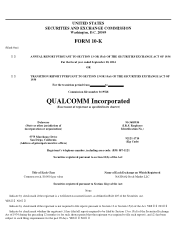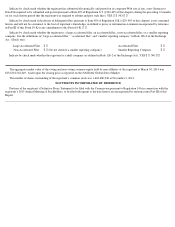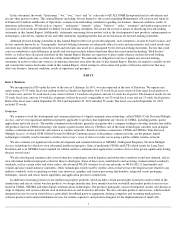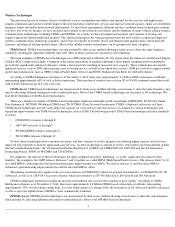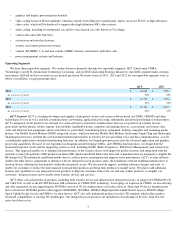Qualcomm 2014 Annual Report Download - page 9
Download and view the complete annual report
Please find page 9 of the 2014 Qualcomm annual report below. You can navigate through the pages in the report by either clicking on the pages listed below, or by using the keyword search tool below to find specific information within the annual report.
are classified as 4G technology. We continue to play a significant role in the development of LTE and LTE Advanced, which are the
predominant 4G technologies.
The primary OFDMA-based technology is LTE, which is incorporated in 3GPP specifications starting from release 8. LTE has two modes,
FDD (frequency division duplex) and TDD (time division duplex), to support paired and unpaired spectrum, respectively, and is being developed
by 3GPP. The principal benefit of LTE is its ability to leverage wide swaths of spectrum (bandwidths of 10 MHz or more). LTE is designed to
seamlessly interwork with 3G through 3G/4G multimode devices. Currently, most LTE devices rely on 3G for voice services across the network,
as well as for ubiquitous data services outside the LTE coverage area, and on 4G for data services inside the coverage area. To date, LTE’
s voice
solution, VoLTE (voice over LTE), has been commercially deployed in only a small number of networks.
LTE’s releases are often combined and given “marketing” or “trade” names that also indicate their benefits. The name LTE covers releases
8 and 9. Releases 10 and beyond are referred to as LTE Advanced. According to GSMA Intelligence estimates as of November 3, 2014, there
were approximately 360 million global 3G/4G multimode connections worldwide, representing approximately 5% of total cellular connections.
Carrier aggregation, one of the significant improvements of LTE Advanced, was commercially launched in June 2013. Along with carrier
aggregation, LTE Advanced brings many more enhancements, including advanced antenna techniques and optimization for small cells. LTE
Advanced continues to evolve; release 12 is expected to be finalized toward the end of calendar 2014, and the work on release 13 has already
started. Apart from improving the performance of existing networks, these releases also bring new enhancements, such as LTE Direct for
proximity-based device-to-device discovery, the ability to use LTE Advanced in unlicensed spectrum, improved LTE broadcast through carrier
aggregation with LTE Advanced in licensed spectrum and optimizations of machine-type communications. (LTE in unlicensed spectrum can be
commercialized in countries such as the United States, China and South Korea with the existing release 10 standard; however, it will need new
standards in many other countries.) The evolution of LTE will significantly expand the role of LTE Advanced in the future of communications.
There also have been ongoing efforts to make the interworking between LTE and Wi-Fi more seamless and completely transparent to the
users. The seamless interworking will also enable the device to use the best possible link or links depending on conditions of the LTE and Wi-Fi
links as the applications run on devices.
Other (Non-cellular) Wireless Technologies. There are other non-cellular wireless technologies that have also been broadly adopted in
mobile cellular devices.
Wireless Local Area Networks. Wireless local area networks (WLAN, also known as Wi-
Fi) link two or more devices wirelessly and usually
provide connectivity through an access point. WLAN systems have been standardized by the Institute of Electrical and Electronics Engineers
(IEEE) in the 802.11 family of standards. 802.11ac, which includes advanced features, such as multiple user multiple in/multiple out (MU
MIMO) and support for large bandwidths and higher order modulation, primarily targets broadband connectivity for mobile devices, laptops and
consumer electronics devices using 5 GHz spectrum. 802.11ad provides multi-gigabit data rates for short range communication, using 60 GHz
spectrum. 802.11ah, which is still under development and targets sub-GHz spectrum, is envisioned to be a solution for “connected home”
applications that require long battery life. We played a leading role in the development of 802.11ac, 802.11ad and 802.11ah.
Bluetooth. Bluetooth is a wireless personal area network that provides wireless connectivity between devices over short distances ranging
from a few centimeters to a few meters. Bluetooth technology provides wireless connectivity to a wide range of fixed or mobile consumer
electronics devices. Bluetooth functionalities are standardized by the Bluetooth Special Interest Group in various versions of the specification
(from 1.0 to 4.0), which include different functionalities, such as enhanced data rate or low energy (known as Bluetooth Smart).
Location Positioning Technologies. Location positioning technologies have evolved rapidly in the industry over the past few years in order
to deliver an enhanced location experience. In the past, satellite navigation systems were predominantly used to provide the accurate location of
mobile devices. We were a key developer of the Assisted-GPS (A-GPS) positioning technology used in most cellular handsets today. For uses
requiring the best accuracy for E911 services and navigational based services, A-GPS provided a leading-edge solution.
The industry has now evolved to support additional inputs for improving the location experience. We now support multiple constellations,
including: GPS, GLONASS (Global Navigation Satellite System) and BeiDou; terrestrial-based positioning using WWAN (Wireless Wide Area
Network) and Wi
-Fi-based inputs; Wi-Fi RSSI (received signal strength indication) and RTT (round-trip time) signals for indoor location; and
third-party sensors combined with GNSS (Global Navigation Satellite System) measurements to provide interim support for location-based
services in rural areas and indoors, where other signal inputs may not be available.
Other Significant Technologies used in Cellular and Certain Consumer Electronic Devices and Networks
We have played a leading role in developing many of the other technologies used in cellular and certain consumer electronic devices and
networks, including:
4


